This is the website of Abulsme Noibatno Itramne (also known as Sam Minter).
Posts here are rare these days. For current stuff, follow me on Mastodon
|
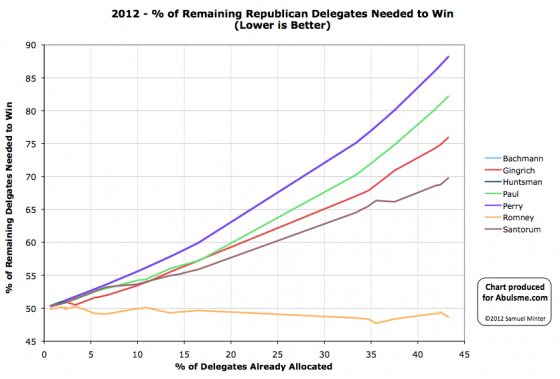
Chart from the Abulsme.com 2012 Republican Delegate Count Graphs page. When a candidate gets down to 0%, they have cinched the nomination. If they get up past 100%, they have been mathematically eliminated. Rather than the date on the x-axis, we show the “% of Delegates Already Allocated” as this better represents the progress through the race. Note that these numbers include estimates of the eventual results of multi-stage caucus processes which will be refined as the later stages occur.
So. Puerto Rico. Romney wins by a huge margin. He got more than 80% of the vote. In second place Santorum got less than 10% of the vote. 50% was the magic number though. The rules for Puerto Rico said that if the winner gets more than 50%, then the delegates are allocated winner take all. So Romney gets all 20 regular delegates from Puerto Rico. (Romney already had 2 of the 3 super delegates from Puerto Rico before tonight, with Gingrich having the remaining super delegate.)
Obviously getting 100% of today’s delegates is good for Romney, and bad for everybody else. Duh. Romney’s best position so far was still on March 10th, right after Guam and the Northern Marianas results, but before Kansas and the Virgin Islands. But he moves back toward the nomination, and away from the possibility of not getting to 1144 with this result. The others continue on their rapid path toward mathematical elimination. In terms of the magical “% of remaining delegates needed to win” number:
- Romney: 49.4% -> 48.7%
- Santorum: 68.7% -> 69.8%
- Gingrich: 74.8% -> 75.9%
- Paul: 80.9% -> 82.2%
Next up is Illinois. Romney is ahead in the polls in Illinois, but isn’t over 48.7% in those polls, and of course nobody else is close to the numbers above either. The contest there is a “Loophole Primary” which is a bit odd, but if the delegate results are even close to being proportional to the popular vote result, then we can expect Illinois to be another of the “everybody loses” states where nobody actually gets closer to the nomination in terms of being on pace to win.
Add that to Louisiana, which will almost certainly also be an “everybody loses” state and we should wrap up the March contests with basically the same situation we have right now… the 3-non Romney’s with no chance of winning, but Romney still in the zone where being blocked from 1144 is very much still within the realm of possibility.
And then we’ll have April.
One thing to watch… does Romney remain in the zone where his “% of remaining needed to win” is less than the “% of delegates so far” number. If so, then continuing at the same pace will eventually get him to 1144, just really slowly. If not, then he’ll actually not be on a winning pace, and will have to actually improve his delegate collection rate to win. (Right now Romney has 51.9% of the delegates so far, compared to needing only 48.7% of the remaining delegates to win.)
| In the latest Curmudgeon’s Corner…
Sam and Ivan talk about:
- Election 2012
- New iPad Launch
- Iran / Syria
- TAL Retraction
Just click to listen now:
[wpaudio url=”http://www.abulsme.com/CurmudgeonsCorner/cc20120318.mp3″ text=”Recorded 18 Mar 2012″]
or
 1-Click Subscribe in iTunes 1-Click Subscribe in iTunes
 View Podcast in iTunes View Podcast in iTunes
 View XML Feed View XML Feed
|
 |
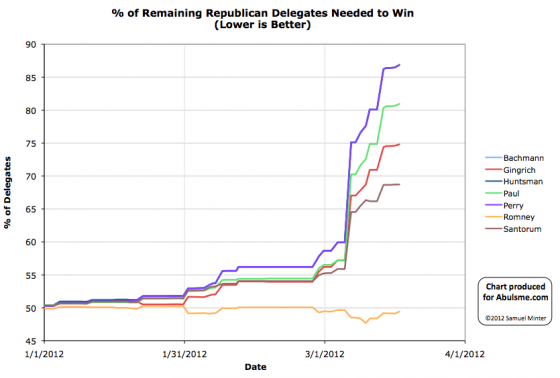
Chart from the Abulsme.com 2012 Republican Delegate Count Graphs page. When a candidate gets down to 0%, they have cinched the nomination. If they get up past 100%, they have been mathematically eliminated. Note that these numbers include estimates of the eventual results of multi-stage caucus processes which will be refined as the later stages occur.
Looks like we finally have final results for all the delegates from Alabama, and what will (maybe?) be a final update for Hawaii as well. All of this from Green Papers of course.
In Alabama we add 4 more delegates for Santorum and 2 more for Gingrich. This brings the total for non-Super delegates in Alabama to 22 Santorum, 14 Gingrich, 11 Romney. (Santorum also has one of the three superdelegates for the state, the other two haven’t endorsed yet.)
In Hawaii, the update we listed on March 15th is reversed. At that time a delegate was removed from the Paul column and given to Romney. Today that delegate appears to go back into the Paul column. This leaves Hawaii at 9 Romney, 5 Santorum, 3 Paul. So +1 Paul, -1 Romney.
So the net for today’s update: Santorum +4, Gingrich +2, Paul +1, Romney -1.
This gives changes for the “% of remaining needed to win” number as follows:
- Romney: 49.13% -> 49.43%
- Santorum: 68.71% -> 68.72%
- Gingrich: 74.60% -> 74.79%
- Paul: 80.65% -> 80.94%
Notice that everybody goes up. This is a small number of delegates of course, and pretty small changes to the numbers, but nobody here actually improved their position in terms of being able to get to 1144. Of the net 6 new delegates today, Santorum got 4. So 66.67%. Which is quite a healthy percentage. Overwhelmingly wins the day. But he would have had to have done even better to actually be on a pace to catch up with Romney. Lots of splits like this lead toward nobody getting 1144.
But this was a minor update day with a small number of delegates. We’ll see what the real contests get us over the coming week.
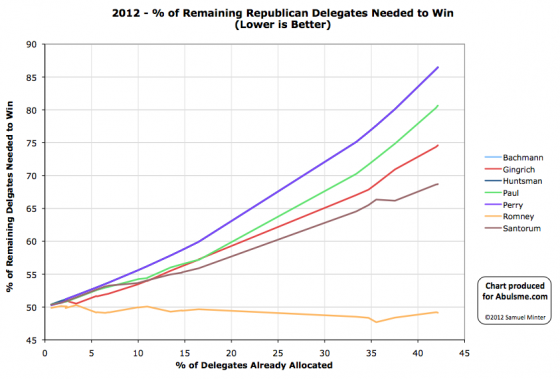
Chart from the Abulsme.com 2012 Republican Delegate Count Graphs page. When a candidate gets down to 0%, they have cinched the nomination. If they get up past 100%, they have been mathematically eliminated. Rather than the date on the x-axis, we show the “% of Delegates Already Allocated” as this better represents the progress through the race. Note that these numbers include estimates of the eventual results of multi-stage caucus processes which will be refined as the later stages occur.
Very minor update today. One new superdelegate from Indiana endorsed Romney. You can barely see the effect on the charts with a microscope. If one must look, Romney’s “% of remaining needed to win” drops from 49.17% to 49.13%. Santorum’s rises from 68.66% to 68.71%. At this stage, one delegate barely budges the numbers.
So we await Puerto Rico this weekend for the next big batch of delegates.
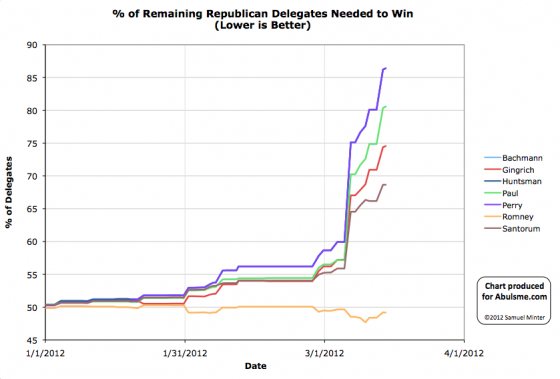
Chart from the Abulsme.com 2012 Republican Delegate Count Graphs page. When a candidate gets down to 0%, they have cinched the nomination. If they get up past 100%, they have been mathematically eliminated. Note that these numbers include estimates of the eventual results of multi-stage caucus processes which will be refined as the later stages occur.
Some minor updates today as results get finalized in the last round of states. In Alabama 3 of the 9 non-super delegates that Green Papers still had as TBD have been determined… 2 for Santorum, 1 for Romney. Meanwhile, in Hawaii the Green Papers estimate gets revised from 9 Romney, 5 Santorum, 3 Paul to 10 Romney, 5 Santorum, 2 Paul. So in Hawaii +1 for Romney, -1 for Paul.
Net for the day: +2 Romney, +2 Santorum, -1 Paul
There are still 6 non-super delegates in Alabama in the TBD category, so we haven’t heard the last from Alabama.
Since this is only a very small number of delegates, the effects are very small. In terms of “% of remaining needed to win”:
- Romney: 49.21% -> 49.17%
- Santorum: 68.65% -> 68.66%
- Gingrich: 74.38% -> 74.55%
- Paul: 80.33% -> 80.59%
Obviously this changes nothing at all about the analysis of the state of the race that was presented yesterday.
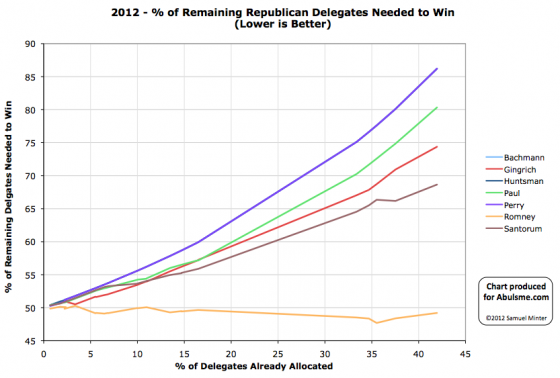
Chart from the Abulsme.com 2012 Republican Delegate Count Graphs page. When a candidate gets down to 0%, they have cinched the nomination. If they get up past 100%, they have been mathematically eliminated. Rather than the date on the x-axis, we show the “% of Delegates Already Allocated” as this better represents the progress through the race. Note that these numbers include estimates of the eventual results of multi-stage caucus processes which will be refined as the later stages occur.
OK, bottom line here… this is not the big win for Santorum that many people are crowing about this morning. He didn’t come close to the numbers he would need to be able to catch up and get to 1144. He didn’t even get the most delegates today. Romney did. But this was also not a win for Romney. As many anticipated, he did not get the percentages of delegates he needed to stay on pace for 1144 and fell back a bit, keeping the possibility of the non-Romney’s preventing Romney from getting to 1144 alive.
OK, now lets hit the details. The states with updates today:
- Alabama: +16 Santorum, +12 Gingrich, +10 Romney (9 regular delegates and 2 super delegates still TBD)
- Mississippi: +13 Santorum, +12 Romney, +12 Gingrich (2 super delegates still TBD)
- Hawaii: +9 Romney, +5 Santorum, +3 Paul (3 super delegates still TBD)
- American Samoa: +9 Romney
- Georgia: +2 Gingrich, -2 Romney (Revision to Georgia results based on updated computations)
So, total for the day: Romney +38, Santorum +34, Gingrich+26, Paul +3
Before anything else, lets just point out again… Romney got the most delegates today. Romney was ahead when this started. So Romney increased his lead today. How is this a win for Santorum? (The answer of course is the spin that gets put on things… which could in turn affect what happens in the next few states… but in the end it will come down to the cold hard numbers… )
So, for Romney going into today, to maintain his pace toward 1144, he needed to get 48.4% of the delegates. Did he manage that? 38/101 = 37.6%. No. He fell short by a significant margin. This WAS a bad day for Romney, no way to disguise it. His “% of remaining needed to win” rises to 49.2%. So far he has 51.2% of the delegates according to the count we use (GreenPapers Soft Count), so if he just continues at that pace he WILL get to 1144… eventually. But this remains in the zone where Romney is vulnerable to be stopped. So far the collective non-Romney’s have managed to get 48.8% of the delegates. They only have to up their game a little bit… such that collectively they are managing 50.8%… to be able to block Romney. This is obviously NOT where Romney would like to be. He wants to be at the point where his “% needed to win” keeps dropping toward zero. But that just isn’t happening yet, and if Santorum gains “momentum” out of his Alabama and Mississippi wins, then it may yet be awhile. If Romney slips under the mark of “50% of the delegates awarded so far” in the next few contests, expect the talk of brokered conventions to accelerate rapidly.
How about Santorum? Well, despite the positive headlines, in terms of actually winning the nomination, despite his wins in two states, today was not good for him. Coming into this round, he needed to be getting 66.2% of the delegates to be on a pace to catch up and win. He got 34/101=33.7% which is nowhere even close. As a result, his “% needed to win” rises dramatically to 68.7%. This is essentially an impossible number as long as all four candidates continue to get support. Even if Gingrich and Paul drop out, this would be an insane winning margin in a two man race. Not going to happen. The only scenarios where Santorum starts to get close are ones where Gingrich and Paul not only drop out, but their delegates en masse and unanimously jump over to Santorum. This would drop Santorum’s “% needed to win” to the 50.8% needed for the non-Romney’s mentioned above. That isn’t going to happen either though.
The situation is of course even worse for Gingrich and Paul. All three of these guys are racing toward mathematical elimination. So the only interesting scenario remains if the three of them collectively can get enough delegates to stop Romney from getting to 1144. The three candidates at this point have all but admitted this. As we have mentioned before, this scenario relies on the three of them being able to continue getting delegates… and getting them at a higher rate than they have so far… even though it is impossible for any of them to individually win. This is still in the realm of the possible though. They have to win the spin war by winning states, even if not by enough delegates to catch up, pushing things explicitly as “Stop Romney”, etc. By all reports the rest of March is still marginal for Romney. If Santorum gains some momentum from states like Alabama and Mississippi and can push hard on the “We must stop Romney” angle, wins some more states in March and then starts driving down Romney support in post-March states, then this remains very much on the table. And then of course the idea is, if it actually goes to the convention undecided, then anything can happen.
Fundamentally the basic analysis of where we are remains the same as it has been since Super Tuesday, and arguably since Florida… or even since Iowa… namely, the non-Romney’s get further away from the nomination with almost every contest (the only exceptions so far being South Carolina and Kansas). Meanwhile Romney continues to hover in the zone where if he continues exactly how he has been going he will win EVENTUALLY, but it will take a long time, and if his opponents collectively improve their performance just a LITTLE BIT, they could block him and force some convention drama.
Edit 2012 Mar 13 18:11 UTC to correct one place where I had incorrectly said Romney when I actually meant Gingrich. Thanks Paolo for pointing it out.
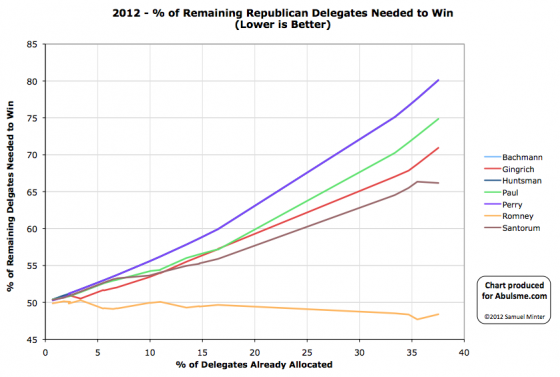
Chart from the Abulsme.com 2012 Republican Delegate Count Graphs page. When a candidate gets down to 0%, they have cinched the nomination. If they get up past 100%, they have been mathematically eliminated. Rather than the date on the x-axis, we show the “% of Delegates Already Allocated” as this better represents the progress through the race. Note that these numbers include estimates of the eventual results of multi-stage caucus processes which will be refined as the later stages occur.
For the first time since Gingrich won South Carolina, someone other than Romney ends up improving their overall position after a day with results from major contests. Yes, Santorum actually pulled one out!
In Kansas Santorum won 33 delegates to Romney’s 7. In the Virgin Islands, Romney won 4 delegates, Paul won 1. Romney also picked up one additional superdelegate from the Virgin Islands. This makes the totals for the day: Santorum 33, Romney 12, Paul 1.
In order to be on a pace to catch up and get to 1144, Santorum needed 66.4% of the delegates. With 33/46 he manages 71.7% of today’s delegates. This means his “% of remaining needed to win” drops to 66.2% for the next set of contests on Tuesday.
So not only does Santorum win the day, he wins the day by a big enough margin to be on pace to win! Well, we would be if he did this every single time there was a contest, which won’t happen, but hey, today, he did it today! (Note: If you counted the two Pacific Island contests that I gave the results of yesterday as if they were all on the same day as Kansas and the Virgin Islands, Santorum would no longer be up for the day.)
Meanwhile, all of the other candidates of course moved backwards, including Romney. Romney moves from needing 47.7% of the remaining delegates to needing 48.4% of the remaining delegates. He will be hard pressed to make this margin in Tuesday’s deep South contests, so expect that he may move backwards some more before moving toward the nomination again, but he is still in the commanding position in this race. Nobody else is even close. He is the only one with a path to 1144. (Prospects for the non-Romney’s to block remain possible however, although the non-Romney’s have to pick up the collective delegate getting pace to make that happen, rather than fading as their chances of winning individually rapidly go to zero.)
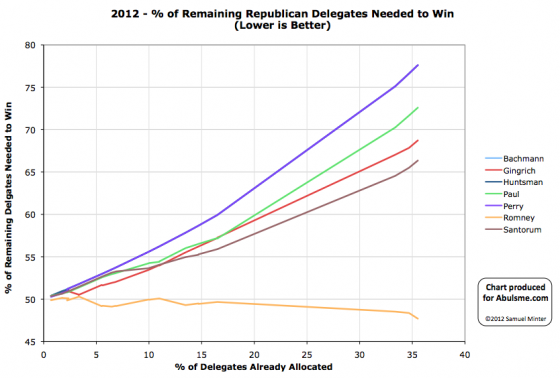
Chart from the Abulsme.com 2012 Republican Delegate Count Graphs page. When a candidate gets down to 0%, they have cinched the nomination. If they get up past 100%, they have been mathematically eliminated. Rather than the date on the x-axis, we show the “% of Delegates Already Allocated” as this better represents the progress through the race. Note that these numbers include estimates of the eventual results of multi-stage caucus processes which will be refined as the later stages occur.
This is the kind of day the not-Romneys wish wouldn’t happen. It is the kind of day that starts taking even the possibility of keeping Romney from getting to 1144 off the table. It highlights Romney’s superior organization and money by letting him get delegates somewhere the others probably hadn’t even thought of competing.
Neither Guam nor the Northern Mariana Islands were technically winner take all. There had been no polling at all. But when all was said and done, support for Romney here was overwhelming (actually unanimous in the small Guam Caucus) and it ended up effectively winner take all. Officially the delegates from these contests are supposed to be uncommitted, but in both locations, the result was made clear. Out of these two locations Romney gets 12 regular delegates. Also 6 super delegates from these locations also are now in the Romney column. Plus, one super delegate from the Virgin Islands also came out for Romney. That makes Romney’s take for the day a 19 delegate gain, while all other candidates were shut out completely.
So Romney’s “% of remaining needed to win” drops from 48.4% to 47.7%. Meanwhile Santorum as the closest competition goes from needing 65.5% to needing 66.4%. Santorum and the others continue to race toward mathematical elimination with each contest. Romney isn’t “racing” toward cinching the nomination yet, but he is making steady progress in that direction now. Some of the Southern states coming up may slow or reverse that process in the short term, but it getting increasingly hard to game out scenarios where Romney does not eventually get to 1144. It is just a question of how long it takes.
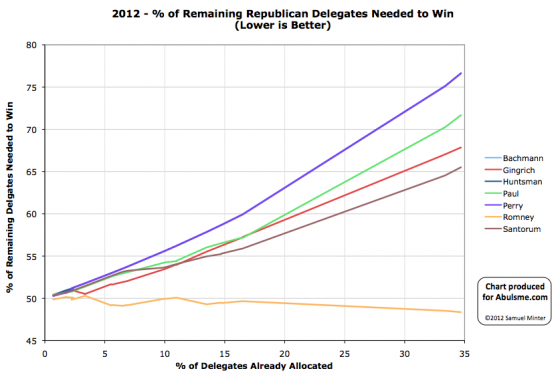
Chart from the Abulsme.com 2012 Republican Delegate Count Graphs page. When a candidate gets down to 0%, they have cinched the nomination. If they get up past 100%, they have been mathematically eliminated. Rather than the date on the x-axis, we show the “% of Delegates Already Allocated” as this better represents the progress through the race. Note that these numbers include estimates of the eventual results of multi-stage caucus processes which will be refined as the later stages occur.
So it appears that the last 34 delegates from Super Tuesday, a handful each from Georgia, Ohio and Tennessee, have been determined. 17 more to Romney, 8 more to Gingrich and 5 more to Santorum. But wait, that is only 30! Well, according to Green Papers, 4 of the 63 delegates that were up for grabs in Ohio end up officially “Uncommitted”, which (I think) means we won’t actually know which way they may go until we know which actual human beings end up being those delegates and those people say publicly who they plan on supporting (which they may or may not actually do before the convention).
All in all, today’s results are once again a win for Romney. He got 56.7% of today’s delegates, which was way more than the 48.5% he needed to continue to move closer to the nomination rather than further way. His “% of remaining needed to win” drops now to 48.4%. For the other candidates, the effect on the other side is more dramatic. Santorum is still in 2nd place, but his “% of remaining needed to win” moves up from 64.5% to 65.5%. Romney may not yet be rapidly moving toward cinching the nomination, but the non-Romneys are rapidly moving toward being mathematically eliminated.
Looking at the non-Romney’s for a minute, the next few states are expected to favor them. Perhaps Santorum will win some. Perhaps Gingrich will win some. But to actually be on a pace to win, Santorum has to not just win a state, but win by a huge margin, getting more than 65.5% of the delegates. For Gingrich it is even worse, he would need to win getting 67.8% of the delegates. (For completeness, Paul would need to get more than 71.7%.)
Even with Romney expected to not be strong in these states, with four candidates in the race, you don’t expect anybody to be able to pull that kind of level except in winner take all (or winner take almost-all) states. Of the next few coming up… in Kansas, Guam, Northern Marianas, Virgin Islands, Alabama, Mississippi, Hawaii and American Samoa there are as usual complicated delegate rules (and the territories might only select uncommitted delegates), but none of them are straight up winner takes all. (Some allow for certain situations that could lead there though.) Bottom line, 65.5% (or more) is a pretty big ask and seems unlikely.
Which means that even if Santorum or Gingrich win some states (as expected) in terms of delegates they will almost certainly still both be heading closer to mathematical elimination rather than closer to the nomination. The big thing to look at will once again be looking at how well the non-Romney’s collectively block Romney from getting the 48.4% of the delegates he needs to be closing in on the nomination himself. With strong performance by the non-Romney’s in the next few contests, they may well be able to achieve this, even if they don’t actually help themselves individually.
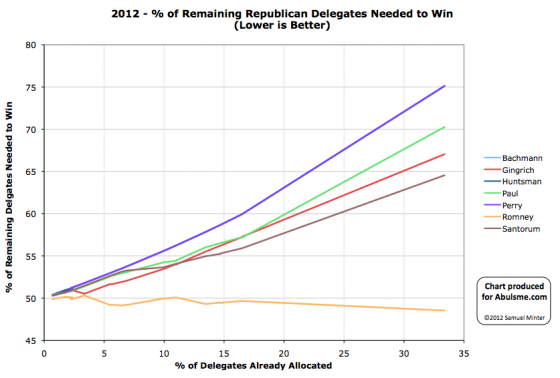
Chart from the Abulsme.com 2012 Republican Delegate Count Graphs page. When a candidate gets down to 0%, they have cinched the nomination. If they get up past 100%, they have been mathematically eliminated. Rather than the date on the x-axis, we show the “% of Delegates Already Allocated” as this better represents the progress through the race. Note that these numbers include estimates of the eventual results of multi-stage caucus processes which will be refined as the later stages occur.
So, Super Tuesday happened. As of this update, Green Papers has “called” 385 of the 419 delegates available from the Super Tuesday contests. There are 34 delegates that haven’t been determined yet that will result in updates later, but of the ones we do know, the estimates for Super Tuesday contests are: Romney 208, Santorum 84, Gingrich 72, Paul 21. Romney also picked up a Superdelegate, bringing the total for the day to Romney 209, Santorum 84, Gingrich 72, Paul 21.
Compared to the Sabato Crystal Ball projections which we used to game out Super Tuesday over the weekend, Romney performed better than expectations, as did Gingrich. Santorum and Paul underperformed compared to those predictions. In any case, where does this put us…
Bottom line, Romney is the big winner today, and this may be the start of him actually pulling away and heading toward the nomination, but he is still not out of the woods in terms of the danger of being blocked from 1144. Lets look at the details.
The situation for Santorum, Gingrich and Paul is essentially what I mapped out in the gaming Super Tuesday post. To paraphrase what I said there, it is now absolutely undeniably clear (although the trend was obvious even before today) that none of these three guys are on a path to the nomination. Of the three, Santorum is doing the best, but with today’s numbers, to be on a path to win, he would need to now get 64.5% of the remaining delegates, compared to the 21.1% he has gotten so far. For this to even come into the realm of possibility, Gingrich and Paul would both have to stop getting delegates, Santorum would have to pick up all of their support, AND something would need to happen to cause support for Romney to plummet. This is a very unlikely sequence of events. It isn’t going to happen.
Oh, I guess I should also note that Gingrich pulled back ahead of Paul for 3rd place.
The remaining question is: “Are the non-Romney’s collectively still in a position to potentially block Romney from getting to 1144?” If after today, Romney was under 50% of the total delegates, and his “% of remaining needed to win” was heading upward or flat, this is a possibility that would be looking like it was still very much in play. But Romney exceeded the 49.7% of delegates he needed in order to be on track toward 1144, and did it by a decent margin. Of the delegates in today’s total, he picked up 209 of 386, or 54.1%. This reduced his “% of remaining needed to win” from 49.7% to 48.5%. That means to block, the non-Romney’s collectively need to be getting 51.5% of the delegates, compared to the 46.9% they have managed so far. So they have to do better than they have been so far, and by a non-trivial margin. And they have do do this even though it is obvious none of them can win outright. It has to be about stopping Romney.
Now, the rest of March has a bunch of states that are supposed to be relatively good for the non-Romneys. So the non-Romney’s managing to get 51.5% in the next few state is very much within the realm of possibility. After that we hit more Romney friendly states in April. The thing to watch for in the upcoming states is not who wins the popular vote, or even the delegate count. The question will be: “Is Romney continuing to get enough delegates to avoid being blocked?” Right now, that magic number is 48.2%. As long as he is getting 48.2% of the delegates (or more) then he is marching his way toward the nomination. If he gets less than that, then blocking will remain possible a little bit longer. If the rest of March really is friendly to the non-Romneys, we may see that Romney’s “% needed to win” starts heading back up a bit before Romney hits friendly states again and starts fully pulling away. As long as we see that happening, blocking Romney is still a possibility. And indeed, if Romney is damaged by the contests in March and his April states start looking not so good after all, then blocking starts looking more real again.
But Romney’s “% of remaining needed to win” is the smallest it has been so far, and none of the other candidates have realistic shots at winning, only a shot at blocking that relies on them continuing to win delegates even though it is obvious they can’t win, so Romney is in a pretty good position right now. Watch that line though. Until it starts heading downward decisively, Romney hasn’t got it wrapped up just yet.
So what is next? Well, first, the last 34 delegates from Super Tuesday (they are from Georgia, Ohio and Tennessee). Then on Sunday we have Kansas (40), Guam (9), Northern Marianas (9), Virgin Islands (9). Then Tuesday we have Alabama (50), Mississippi (40), Hawaii (20), American Samoa (9). And then it goes on and on…
|
|









